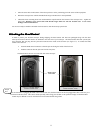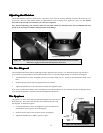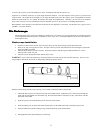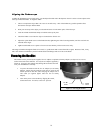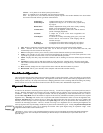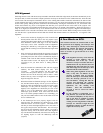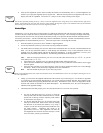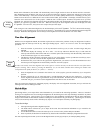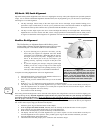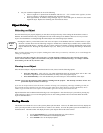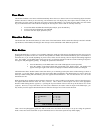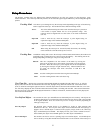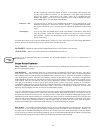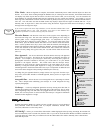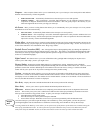
19
Based on this information, the NexStar will automatically select a bright star that is above the horizon and slew towards it.
Once finished slewing, the display will ask you to use the arrow buttons to align the selected star with the cross hairs in the
center of the finderscope. If for some reason the chosen star is not visible (perhaps behind a tree or building) you can press
UNDO to select and slew to a different star. Once centered in the finder, press ENTER. The display will then instruct you to
center the star in the field of view of the eyepiece. When the star is centered, press ALIGN to accept this star as your first
alignment star. After the first alignment star has been entered the NexStar will automatically slew to a second alignment star
and have you repeat this procedure for that star. When the telescope has been aligned to both stars the display will read
Alignment Successful, and you are now ready to find your first object.
If the wrong star was centered and aligned to, the NexStar display will read Alignment Failed and scroll the message,
"the positions of the alignment stars did not match the database". Should this occur, press the UNDO button and re-align the
telescope. Remember the alignment star will always be the brightest star nearest the field of view of the finder.
T
T
w
w
o
o
S
S
t
t
a
a
r
r
A
A
l
l
i
i
g
g
n
n
m
m
e
e
n
n
t
t
With the two-star alignment method, the NexStar requires the user to know the positions of only two bright stars in order to
accurately align the telescope with the sky and begin finding objects. Here is an overview of the two-star alignment
procedure:
1. Once the NexStar is powered on, use the Up and Down scroll keys (10) to select Two-Star Align, and press
ENTER.
2. The NexStar display the message Set Alt to Index . Use the Up and Down direction keys (3) and rotate the
telescope tube until the index marker that moves with the optical tube is lined up with the stationary index marker
on the fork arm (See figure 5-2). Press ENTER.
3. The SELECT STAR 1 message will appear in the top row of the display. Use the Up and Down scroll keys (10) to
select the star you wish to use for the first alignment star. Press ENTER.
4. NexStar then asks you to center in the eyepiece the alignment star you selected. Use the direction buttons to slew
the telescope to the alignment star and carefully center the star in the eyepiece.
In order to accurately center the alignment star in the eyepiece, it will be necessary to decrease the slew rate of the motors
for fine centering. This is done by pressing the RATE key (11) on the hand controller then selecting the number that
corresponds to the speed you desire. (9 = fastest , 1 = slowest).
5. Once the alignment star is centered in the field of view of the eyepiece, press the ALIGN key (2) to accept this
position.
6. NexStar will then ask you to select and center a second alignment star and press the ALIGN key. It is best to
choose alignment stars that are a good distance away from one another. Stars that are at least 40º to 60º apart from
each other will give you a more accurate alignment than stars that are close to each other.
Once the second star alignment is completed properly, the display will read Alignment Successful, and you will hear the
tracking motors turn-on and begin to track.
Q
Q
u
u
i
i
c
c
k
k
-
-
A
A
l
l
i
i
g
g
n
n
Quick-Align allows you to input all the same information as you would for the AutoAlign procedure. However, instead of
slewing to two alignment stars for centering and alignment, the NexStar bypasses this step and simply models the sky based
on the information given. This will allow you to roughly slew to the coordinates of bright objects like the moon and planets
and gives the NexStar the information needed to track objects in altazimuth in any part of the sky. Quick-Align is not meant
to be used to accurately locate small or faint deep-sky objects or to track objects accurately for photography.
To use Quick-Align:
1. Select Quick-Align from the alignment options.
2. The hand control will then ask you to input all the same time and location information as you would for the
AutoAlign procedure.
3. Use the direction buttons to move the telescope to its north and index position and press ENTER.
4. Once in position, the NexStar will model the sky based on this information and display Alignment Successful.
Note: Once a Quick-Align has been done, you can use the Re-alignment feature (see next page) to improve your telescopes pointing accuracy.
Trouble
Shooting
Hel
p
ful
Hint



